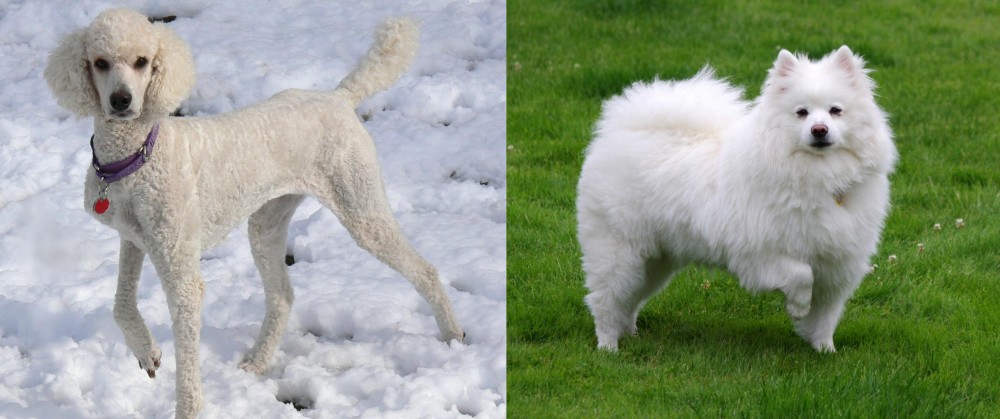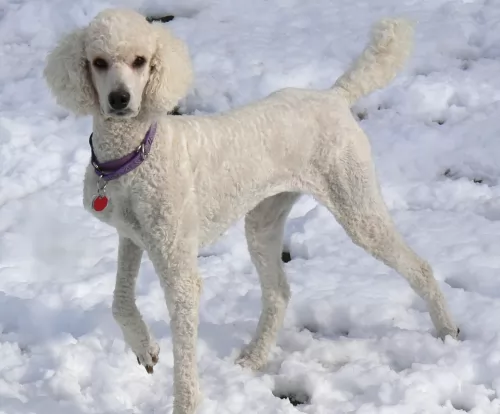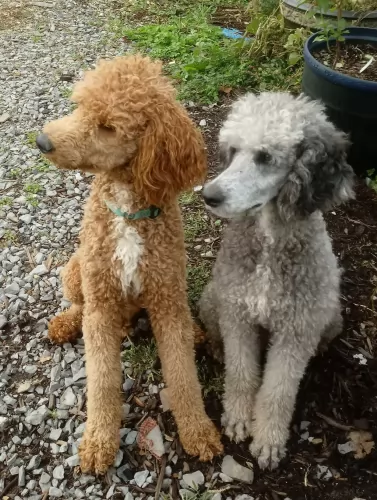 Petzlover
Petzlover Poodle is originated from Germany but American Eskimo Dog is originated from United States. Both Poodle and American Eskimo Dog are having almost same height. Poodle may weigh 18 kg / 40 pounds more than American Eskimo Dog. Both Poodle and American Eskimo Dog has same life span. Poodle may have more litter size than American Eskimo Dog. Both Poodle and American Eskimo Dog requires High Maintenance.
Poodle is originated from Germany but American Eskimo Dog is originated from United States. Both Poodle and American Eskimo Dog are having almost same height. Poodle may weigh 18 kg / 40 pounds more than American Eskimo Dog. Both Poodle and American Eskimo Dog has same life span. Poodle may have more litter size than American Eskimo Dog. Both Poodle and American Eskimo Dog requires High Maintenance.
 Poodles are said to be older breed which is developed to hunt waterfowl. They have their origin in Germany and developed as a breed in France. Many different arguements are there in their development. One of the arguement says that they are developed as a result of crossing European Water dogs. Egyptian and Roman histories have proof of Poodles in their drawings and statues. They were categorized into three types according to their size and are Miniature, Toy and Standard.
Poodles are said to be older breed which is developed to hunt waterfowl. They have their origin in Germany and developed as a breed in France. Many different arguements are there in their development. One of the arguement says that they are developed as a result of crossing European Water dogs. Egyptian and Roman histories have proof of Poodles in their drawings and statues. They were categorized into three types according to their size and are Miniature, Toy and Standard.
 The American Eskimo is derived from the Nordic Spitz breed and most closely related to the German Spitz in particular. There were many German Spitzes in the United States at the time of the second World War and anti-German sentiment caused its name to change to the American Eskimo Dog. However, as the breed developed over time in the States, the American Eskimo became its own separate breed. In addition to the German Spitz, the American Eskimo is also related to the white Keeshond, the Samoyed, the white Italian Spitz and the white Pomeranian.
The history is beginning to show that the Spitzes that were brought to the US in the early 1900’s was white. This color was not popular in Europe but was quickly the favorite in the United States. They were originally working dogs on farms and ranches. They have excellent herding instincts, make goo watch and guard dogs, and good law enforcement sniff dogs. However, their first introduction to the American public was through the Cooper Brothers’ Railroad Circus and Stout’s Pal Pierre at the Barnum and Baily Circus. Eskimo puppies were sold after the circus show.
The American Eskimo is derived from the Nordic Spitz breed and most closely related to the German Spitz in particular. There were many German Spitzes in the United States at the time of the second World War and anti-German sentiment caused its name to change to the American Eskimo Dog. However, as the breed developed over time in the States, the American Eskimo became its own separate breed. In addition to the German Spitz, the American Eskimo is also related to the white Keeshond, the Samoyed, the white Italian Spitz and the white Pomeranian.
The history is beginning to show that the Spitzes that were brought to the US in the early 1900’s was white. This color was not popular in Europe but was quickly the favorite in the United States. They were originally working dogs on farms and ranches. They have excellent herding instincts, make goo watch and guard dogs, and good law enforcement sniff dogs. However, their first introduction to the American public was through the Cooper Brothers’ Railroad Circus and Stout’s Pal Pierre at the Barnum and Baily Circus. Eskimo puppies were sold after the circus show.
It was then that the breed became one of America’s favorite breeds and they quickly became house pets. Following World War II, Japan exported the Japanese Spitz into America and it was crossed with the Eskimo also. The American Eskimo Dog breed was not recognized by AKC until 1985. Still in 1958 there was no official breed club in the States but there were growing numbers of the dogs. It was not until 1970 did the National American Eskimo Dog Association (NAEDA) come into being. They collected the pedigrees of the first 1750 dogs to be AKC registered.
Since the American Eskimo Dog is not recognized internationally, those wishing to participate in international competition such as England’s prestigious Cruft’s Dog Show must register their dogs a German Spitz. Despite this the American Eskimo and German Spitz remain two very different breeds.
 Poodles today lives a luxury life but actually they are bred to do work. They are well known for their intelligence and are really water retriever. This is because they show their energy in hunting waterfowl. The name Poodle is said to got from German word "Pudel" which means "splash in the water".
Poodles today lives a luxury life but actually they are bred to do work. They are well known for their intelligence and are really water retriever. This is because they show their energy in hunting waterfowl. The name Poodle is said to got from German word "Pudel" which means "splash in the water".
Their hair is trimmed in such a way to make them swim easily. Hair is not trimmed in the joints and organs such that to protect them from cold water. Poodles are well known for their wonderful personality and intelligence. Also they are very obedient and a good companion. They won't be happy if left alone for a long time. Poodles are interested in playing games with people. They perform very well if given a proper training. Good manners should be taught to them as they remember all things they have learned.
 This small to medium dog is beautiful and resembles a miniature Samoyed. There are three sizes of American Eskimo – the standard, miniature, and the toy. The Eskimo’s head is wedge shaped with tall, triangular, erect ears. It has a heavily plumed tail with a sharp curl over the back. The Eskimo can burst into bold action due to their good legs and feet.
This small to medium dog is beautiful and resembles a miniature Samoyed. There are three sizes of American Eskimo – the standard, miniature, and the toy. The Eskimo’s head is wedge shaped with tall, triangular, erect ears. It has a heavily plumed tail with a sharp curl over the back. The Eskimo can burst into bold action due to their good legs and feet.
The coat is a double one with a harsh outer coat and plush inner one. The coat is always white or white with cream or biscuit markings, and visible skin in gray or pink. The American Eskimo’s ruff or mane is very heavy, and the nose, eyelids, pads and gums are black. They have dark eyes and blue are not allowed.
 They are good companions and usually likes to spend time with children. Even they are children friendly it is strongly recommended not to leave children alone with them.
They are good companions and usually likes to spend time with children. Even they are children friendly it is strongly recommended not to leave children alone with them.
Poodles are specialist in hunting water birds. They are good in swimming since they are covered with fur water will not easily get into their ears. They are well known for their intelligence like humans.
They are well suited for apartment living but won't be happy if left alone. They will tolerate hot weather better when compared with cold.
They are quick learners and learn good and bad things very quickly. Once they learn, they won't forget it up. Since poodles are so intelligent they are very easy to train.
 The Eskimo is affectionate, playful and love children of all ages. They are intelligent and want to please you. They can be trained easily and are champions of the obedience trial. They are fun and confident. At the same time, they need a confident pack leader. He is prone to Little Dog Syndrome where the dog thinks they oversee the home and display all sorts of behaviors. Under these circumstances the American Eskimo can become obsessive, aggressive, and engaging in obsessive resource guarding and barking.
The Eskimo is affectionate, playful and love children of all ages. They are intelligent and want to please you. They can be trained easily and are champions of the obedience trial. They are fun and confident. At the same time, they need a confident pack leader. He is prone to Little Dog Syndrome where the dog thinks they oversee the home and display all sorts of behaviors. Under these circumstances the American Eskimo can become obsessive, aggressive, and engaging in obsessive resource guarding and barking.
 Poodles have more chances for getting eye diseases such as Progressive retinal atrophy and cataracts. Cancer is also seen in them and there are chances of skin problems such as allergies and tumors.
Poodles have more chances for getting eye diseases such as Progressive retinal atrophy and cataracts. Cancer is also seen in them and there are chances of skin problems such as allergies and tumors.
Usually poodles don't shed at all. Excessive shedding is the smptom of allergies in them. When they get other problems shedding accompanies with it. Even an infection may cause hairfall. Ringworm infections and pests should be controlled using appropriate medicines.
 The American Eskimo Dog is prone to hip dysplasia. Their eyes and tear ducts are potential issues with progressive retinal atrophy. They are allergic to fleas and have a tendency to be overweight.
The American Eskimo Dog is prone to hip dysplasia. Their eyes and tear ducts are potential issues with progressive retinal atrophy. They are allergic to fleas and have a tendency to be overweight.
We deal with PRA (Progressive Retinal Atrophy) in greater detain in a following section but it is not as destructive as it used to be. It is much more treatable now.
There are potentially some dental issues that some American Eskimo Dogs are prone to.
 Usually puppy eats more food than an adult dog. This is because they need more food to support growth. Actully puppies need two to four times more food than adult. Puppies should eat in such a way that their ribs should not be seen and waist must be visible.
Usually puppy eats more food than an adult dog. This is because they need more food to support growth. Actully puppies need two to four times more food than adult. Puppies should eat in such a way that their ribs should not be seen and waist must be visible.
Poodles can be fed with proteinous food, healthy grains, vegetables and fruits. They love to eat organs such as liver, kidney, brain and chicken breast, turkey and fish. Vegetables such as baby carrots, spinach and peas can be given to them. Make them to eat fruits like raspberries, banana and melon.
Dry kibble is not good for their teeth. Even some premium quality foods are not good for their health. Pig's ears are not safe to chew for them. Vaccinations should be made at the right time.
Exercises play an important role in their health and even extend their life. Poodles should be made to walk regularly. Exercising must be done to a particular level and they should not be over exercised.
 Your American Eskimo Dog needs a high quality food so they will not get overweight. Make sure you know how much is appropriate for your particular dog and her specific age. The puppies should be fed twice a day but adults only once.
Your American Eskimo Dog needs a high quality food so they will not get overweight. Make sure you know how much is appropriate for your particular dog and her specific age. The puppies should be fed twice a day but adults only once.
As previously mentioned the American Eskimo Dog is prone to eye issue such as Progressive Retinal Atrophy or (PRA) – this disease is inherited and used to cause blindness as the rods in the retina died. New medical discoveries mean this is no longer a hopeless disease. Their eyes are also susceptible to other issues so make sure you check them and the tear ducts regularly.
Like so many other breeds the American Eskimo is also susceptible to hip dysplasia and a moving patella in the knee. For this reason watch their weight. They can also be very allergic.
This small dog has more energy than his size can handle. He needs a lot of exercise and a place to run. If he will become hyperactive and destructive. They are prone to disturbing behaviors such as spinning (spinning in circles) when they don’t get enough exercise. The American Eskimo Dog is smart and agile, Play games like catch or agility. They are also great at herding, competitive obedience or detection.